Report: Analysis of Management Functions and Organisational Structure
VerifiedAdded on 2021/04/24
|11
|2111
|22
Report
AI Summary
This report provides a comprehensive analysis of management functions, organisational structure, and communication strategies within a London-based cleaning service business. It begins by outlining the four core functions of management: planning, organizing, leading, and controlling, emphasizing their importance in day-to-day operations and ensuring quality service delivery. The report then explores organisational structure, recommending a functional structure for the company based on its size and purpose, highlighting its benefits such as specialist guidance and efficient teamwork. Furthermore, the report delves into organisational culture, identifying a 'Role culture' as the most suitable for the cleaning service business, and discusses its impact on business performance, including attracting talent and fostering employee loyalty. Finally, the report examines effective communication strategies, emphasizing the development of a communication strategy, active listening, avoiding jargon, keeping messages simple, and seeking feedback to prevent conflicts and ensure clear information flow within the company.

Understanding Management
Paraphrase This Document
Need a fresh take? Get an instant paraphrase of this document with our AI Paraphraser

Understanding Management 1
Contents
Task- 1.............................................................................................................................................2
Four Functions of Management...................................................................................................2
Task 2...............................................................................................................................................4
Organisational structure...............................................................................................................4
Benefits........................................................................................................................................5
Task- 3.............................................................................................................................................5
Organisational culture..................................................................................................................5
Importance of culture for business performance.........................................................................6
Task- 4.............................................................................................................................................7
Effective Communication............................................................................................................7
References......................................................................................................................................10
Contents
Task- 1.............................................................................................................................................2
Four Functions of Management...................................................................................................2
Task 2...............................................................................................................................................4
Organisational structure...............................................................................................................4
Benefits........................................................................................................................................5
Task- 3.............................................................................................................................................5
Organisational culture..................................................................................................................5
Importance of culture for business performance.........................................................................6
Task- 4.............................................................................................................................................7
Effective Communication............................................................................................................7
References......................................................................................................................................10

Understanding Management 2
The report is based on the scenario that states that business based in London offers the cleaning
services to the offices, home, and commercial businesses. The business believes in the
commitment to the quality service at the affordable cost and has built the reputation over the past
10 years.
Task- 1
Four Functions of Management
The four function of the management approach that helps in managing the day to day operations
of the business is given below.
Planning- Planning involves the setting of objective and determining the course of action for
achieving the objective. To continue with the day to day operation there is need of planning the
strategies (Norman, 2018). The managers of the business are required to identify the challenges
that can affect the cleaning services and after identification of the requirements the manager can
easily predict the business and economic conditions. Manager form the strategies and planning
helps in allocating resources and reducing the waste.
Organizing- The responsibility of the manager is to bring together the resources that are
required for the cleaning services such as human, finance and physical to accomplish the
objectives. The manager assigns the work task or activities to groups or individuals and
coordinates with them.
Leading- This function of management helps the manager in motivating the employees to
achieve the goals and objective of the company and to maintain the quality of the cleaning
services that company offers to its customers. The leader of the company communicates with the
The report is based on the scenario that states that business based in London offers the cleaning
services to the offices, home, and commercial businesses. The business believes in the
commitment to the quality service at the affordable cost and has built the reputation over the past
10 years.
Task- 1
Four Functions of Management
The four function of the management approach that helps in managing the day to day operations
of the business is given below.
Planning- Planning involves the setting of objective and determining the course of action for
achieving the objective. To continue with the day to day operation there is need of planning the
strategies (Norman, 2018). The managers of the business are required to identify the challenges
that can affect the cleaning services and after identification of the requirements the manager can
easily predict the business and economic conditions. Manager form the strategies and planning
helps in allocating resources and reducing the waste.
Organizing- The responsibility of the manager is to bring together the resources that are
required for the cleaning services such as human, finance and physical to accomplish the
objectives. The manager assigns the work task or activities to groups or individuals and
coordinates with them.
Leading- This function of management helps the manager in motivating the employees to
achieve the goals and objective of the company and to maintain the quality of the cleaning
services that company offers to its customers. The leader of the company communicates with the
⊘ This is a preview!⊘
Do you want full access?
Subscribe today to unlock all pages.

Trusted by 1+ million students worldwide

Understanding Management 3
employees so effective that they can change the perspective of the employees (Klingner,
Nalbandian and Llorens, 2015).
Controlling- This function is one of the important function that includes the measuring
achievement related to the objective and goals of Cleaning services company. In this the
manager of company establishes performance standards, comparing the actual performance with
standard performance and taking corrective actions when required.
How can you ensure your staffs continues to deliver on business goals with an absolute
commitment to quality
The managers of the company can analyse the level of involvement and engagement of the
employees in accomplishing the goal of a company. Moreover, the manager can check the staff
continuity in delivering service quality as per their commitments towards the business (Kant,
2017). The prior objective of the company is maintaining the quality of services in order to
satisfy the needs of customers. Further, the manager can check the improvement in the
performance of the employees which comes when they show their commitments towards the
goals of the company. If there is any problem due to which the employees are not able to deliver
quality in their work then the manager of the business should try to resolve the problems.
Therefore, the employees of the company can contribute in the achievement of the goals.
Task 2
Organisational structure
Companies operate organization structure to generate their business hierarchies. Every company
identifies the staffing to operate them efficiently and for this structure plays a vital role in
employees so effective that they can change the perspective of the employees (Klingner,
Nalbandian and Llorens, 2015).
Controlling- This function is one of the important function that includes the measuring
achievement related to the objective and goals of Cleaning services company. In this the
manager of company establishes performance standards, comparing the actual performance with
standard performance and taking corrective actions when required.
How can you ensure your staffs continues to deliver on business goals with an absolute
commitment to quality
The managers of the company can analyse the level of involvement and engagement of the
employees in accomplishing the goal of a company. Moreover, the manager can check the staff
continuity in delivering service quality as per their commitments towards the business (Kant,
2017). The prior objective of the company is maintaining the quality of services in order to
satisfy the needs of customers. Further, the manager can check the improvement in the
performance of the employees which comes when they show their commitments towards the
goals of the company. If there is any problem due to which the employees are not able to deliver
quality in their work then the manager of the business should try to resolve the problems.
Therefore, the employees of the company can contribute in the achievement of the goals.
Task 2
Organisational structure
Companies operate organization structure to generate their business hierarchies. Every company
identifies the staffing to operate them efficiently and for this structure plays a vital role in
Paraphrase This Document
Need a fresh take? Get an instant paraphrase of this document with our AI Paraphraser
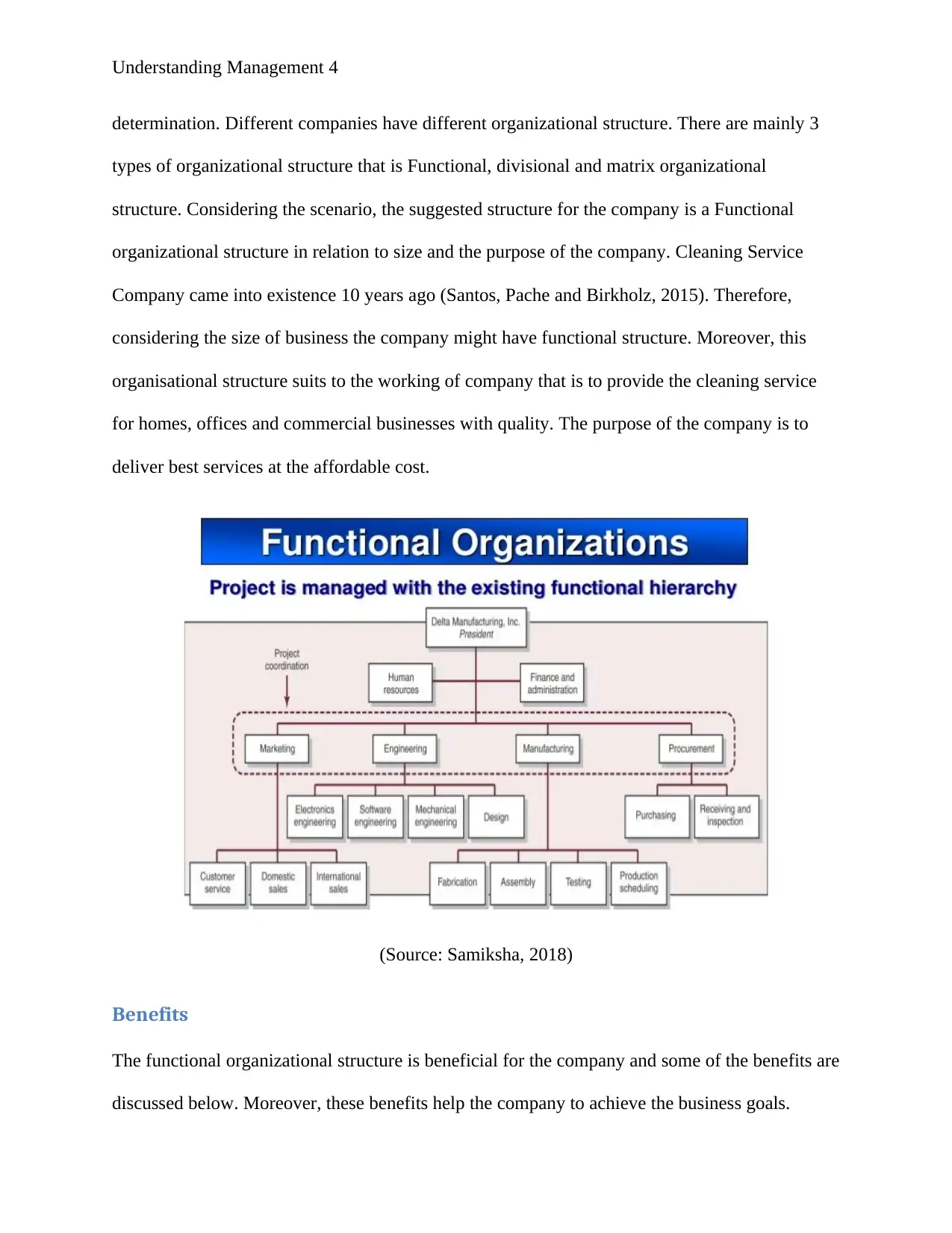
Understanding Management 4
determination. Different companies have different organizational structure. There are mainly 3
types of organizational structure that is Functional, divisional and matrix organizational
structure. Considering the scenario, the suggested structure for the company is a Functional
organizational structure in relation to size and the purpose of the company. Cleaning Service
Company came into existence 10 years ago (Santos, Pache and Birkholz, 2015). Therefore,
considering the size of business the company might have functional structure. Moreover, this
organisational structure suits to the working of company that is to provide the cleaning service
for homes, offices and commercial businesses with quality. The purpose of the company is to
deliver best services at the affordable cost.
(Source: Samiksha, 2018)
Benefits
The functional organizational structure is beneficial for the company and some of the benefits are
discussed below. Moreover, these benefits help the company to achieve the business goals.
determination. Different companies have different organizational structure. There are mainly 3
types of organizational structure that is Functional, divisional and matrix organizational
structure. Considering the scenario, the suggested structure for the company is a Functional
organizational structure in relation to size and the purpose of the company. Cleaning Service
Company came into existence 10 years ago (Santos, Pache and Birkholz, 2015). Therefore,
considering the size of business the company might have functional structure. Moreover, this
organisational structure suits to the working of company that is to provide the cleaning service
for homes, offices and commercial businesses with quality. The purpose of the company is to
deliver best services at the affordable cost.
(Source: Samiksha, 2018)
Benefits
The functional organizational structure is beneficial for the company and some of the benefits are
discussed below. Moreover, these benefits help the company to achieve the business goals.
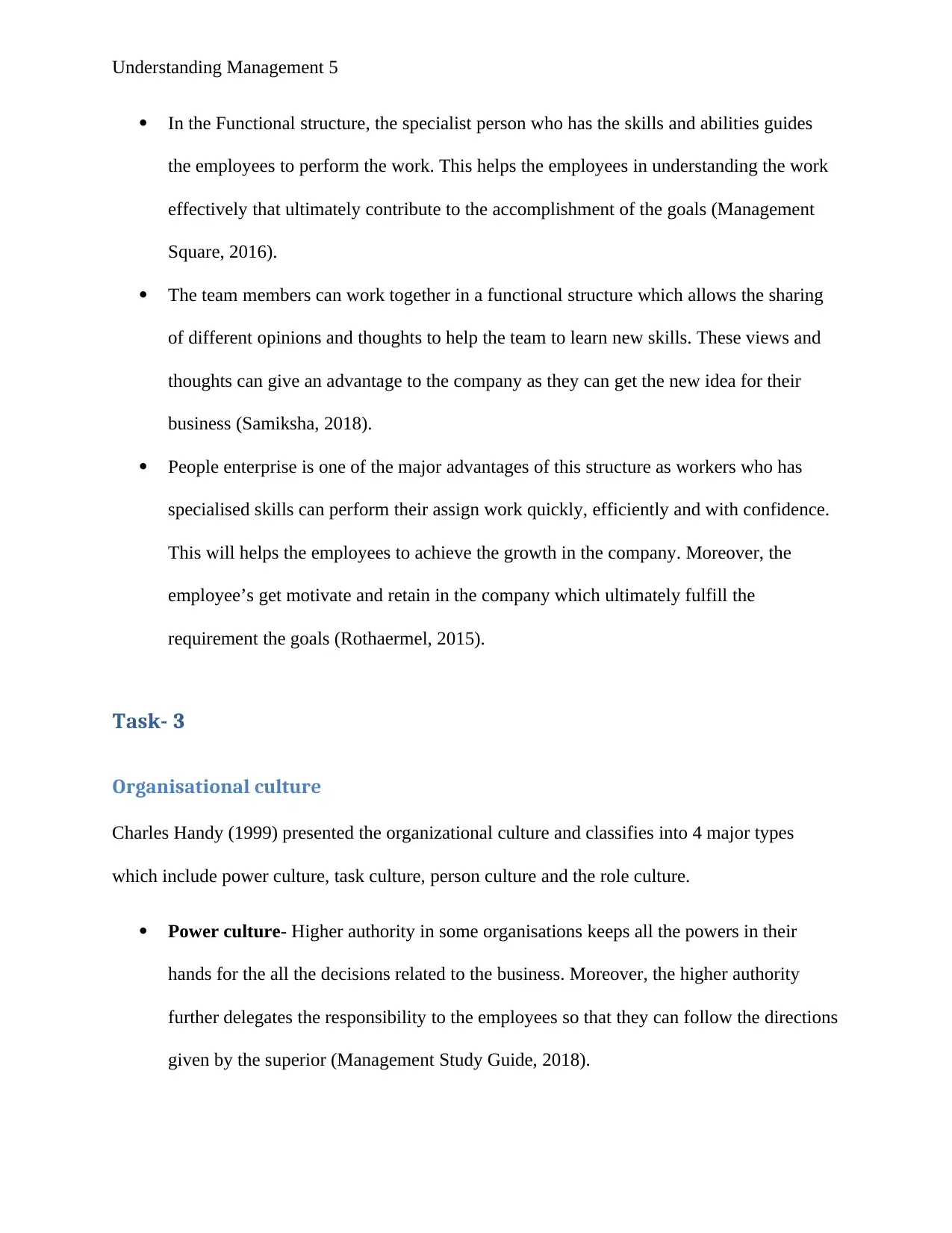
Understanding Management 5
In the Functional structure, the specialist person who has the skills and abilities guides
the employees to perform the work. This helps the employees in understanding the work
effectively that ultimately contribute to the accomplishment of the goals (Management
Square, 2016).
The team members can work together in a functional structure which allows the sharing
of different opinions and thoughts to help the team to learn new skills. These views and
thoughts can give an advantage to the company as they can get the new idea for their
business (Samiksha, 2018).
People enterprise is one of the major advantages of this structure as workers who has
specialised skills can perform their assign work quickly, efficiently and with confidence.
This will helps the employees to achieve the growth in the company. Moreover, the
employee’s get motivate and retain in the company which ultimately fulfill the
requirement the goals (Rothaermel, 2015).
Task- 3
Organisational culture
Charles Handy (1999) presented the organizational culture and classifies into 4 major types
which include power culture, task culture, person culture and the role culture.
Power culture- Higher authority in some organisations keeps all the powers in their
hands for the all the decisions related to the business. Moreover, the higher authority
further delegates the responsibility to the employees so that they can follow the directions
given by the superior (Management Study Guide, 2018).
In the Functional structure, the specialist person who has the skills and abilities guides
the employees to perform the work. This helps the employees in understanding the work
effectively that ultimately contribute to the accomplishment of the goals (Management
Square, 2016).
The team members can work together in a functional structure which allows the sharing
of different opinions and thoughts to help the team to learn new skills. These views and
thoughts can give an advantage to the company as they can get the new idea for their
business (Samiksha, 2018).
People enterprise is one of the major advantages of this structure as workers who has
specialised skills can perform their assign work quickly, efficiently and with confidence.
This will helps the employees to achieve the growth in the company. Moreover, the
employee’s get motivate and retain in the company which ultimately fulfill the
requirement the goals (Rothaermel, 2015).
Task- 3
Organisational culture
Charles Handy (1999) presented the organizational culture and classifies into 4 major types
which include power culture, task culture, person culture and the role culture.
Power culture- Higher authority in some organisations keeps all the powers in their
hands for the all the decisions related to the business. Moreover, the higher authority
further delegates the responsibility to the employees so that they can follow the directions
given by the superior (Management Study Guide, 2018).
⊘ This is a preview!⊘
Do you want full access?
Subscribe today to unlock all pages.

Trusted by 1+ million students worldwide
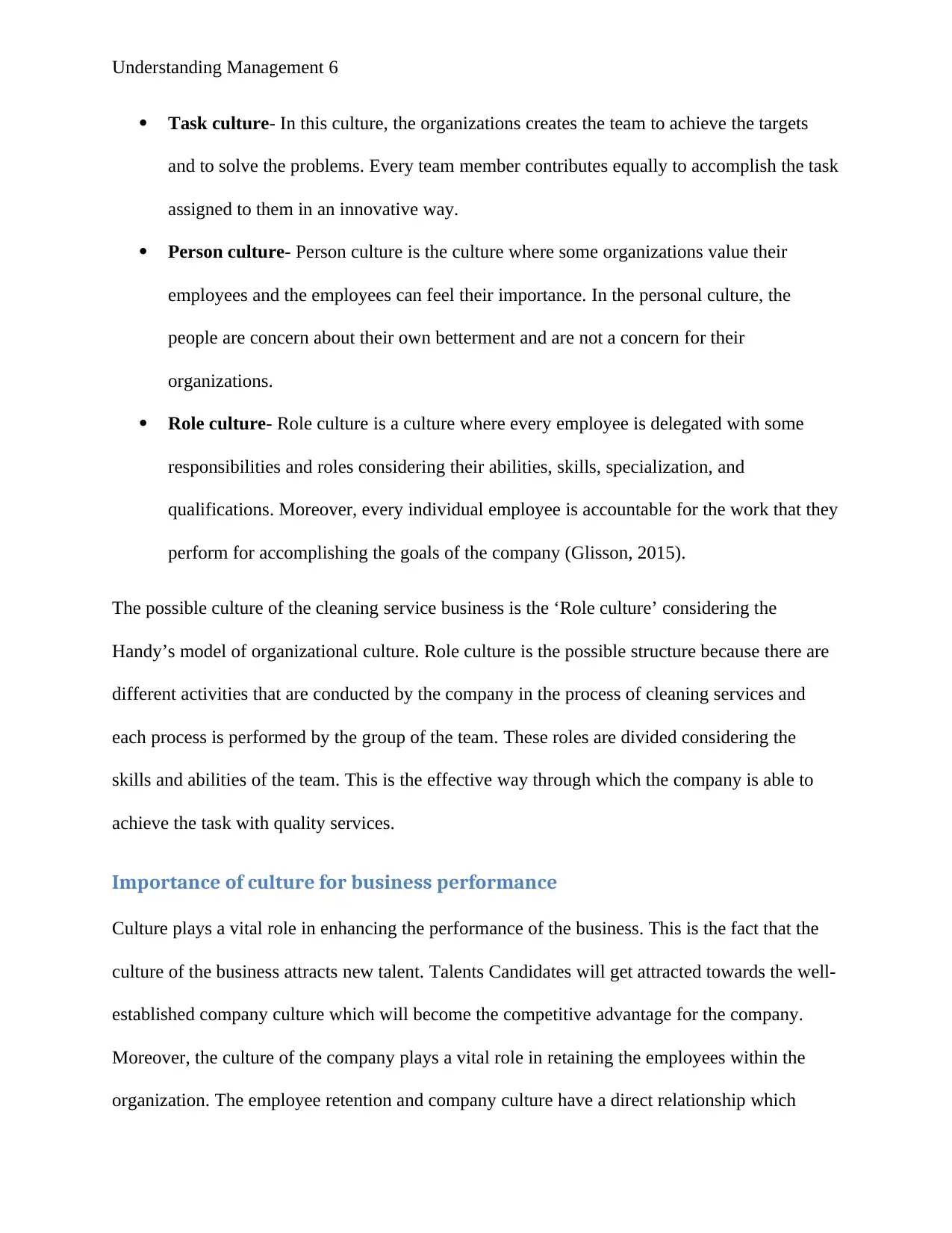
Understanding Management 6
Task culture- In this culture, the organizations creates the team to achieve the targets
and to solve the problems. Every team member contributes equally to accomplish the task
assigned to them in an innovative way.
Person culture- Person culture is the culture where some organizations value their
employees and the employees can feel their importance. In the personal culture, the
people are concern about their own betterment and are not a concern for their
organizations.
Role culture- Role culture is a culture where every employee is delegated with some
responsibilities and roles considering their abilities, skills, specialization, and
qualifications. Moreover, every individual employee is accountable for the work that they
perform for accomplishing the goals of the company (Glisson, 2015).
The possible culture of the cleaning service business is the ‘Role culture’ considering the
Handy’s model of organizational culture. Role culture is the possible structure because there are
different activities that are conducted by the company in the process of cleaning services and
each process is performed by the group of the team. These roles are divided considering the
skills and abilities of the team. This is the effective way through which the company is able to
achieve the task with quality services.
Importance of culture for business performance
Culture plays a vital role in enhancing the performance of the business. This is the fact that the
culture of the business attracts new talent. Talents Candidates will get attracted towards the well-
established company culture which will become the competitive advantage for the company.
Moreover, the culture of the company plays a vital role in retaining the employees within the
organization. The employee retention and company culture have a direct relationship which
Task culture- In this culture, the organizations creates the team to achieve the targets
and to solve the problems. Every team member contributes equally to accomplish the task
assigned to them in an innovative way.
Person culture- Person culture is the culture where some organizations value their
employees and the employees can feel their importance. In the personal culture, the
people are concern about their own betterment and are not a concern for their
organizations.
Role culture- Role culture is a culture where every employee is delegated with some
responsibilities and roles considering their abilities, skills, specialization, and
qualifications. Moreover, every individual employee is accountable for the work that they
perform for accomplishing the goals of the company (Glisson, 2015).
The possible culture of the cleaning service business is the ‘Role culture’ considering the
Handy’s model of organizational culture. Role culture is the possible structure because there are
different activities that are conducted by the company in the process of cleaning services and
each process is performed by the group of the team. These roles are divided considering the
skills and abilities of the team. This is the effective way through which the company is able to
achieve the task with quality services.
Importance of culture for business performance
Culture plays a vital role in enhancing the performance of the business. This is the fact that the
culture of the business attracts new talent. Talents Candidates will get attracted towards the well-
established company culture which will become the competitive advantage for the company.
Moreover, the culture of the company plays a vital role in retaining the employees within the
organization. The employee retention and company culture have a direct relationship which
Paraphrase This Document
Need a fresh take? Get an instant paraphrase of this document with our AI Paraphraser

Understanding Management 7
means the strong culture encourages the people to work together which helps in improving the
performance. The culture contributes in creating the loyal employees within the organization
(DeMers, 2015). Moreover, the company will be able to create a unique identity in the market
with the help of culture that contributes to the goodwill of the company.
Task- 4
Effective Communication
Communication plays a crucial role in the business and there are different strategies and ways
through which the company can ensure effective communication of information in business and
can avoid conflicts.
Develop a communication strategy- Communication strategy will help the business in
ensuring the effective communication. The company should develop an effective strategy
which decides the way in which the information is going to be communicated from one
person to another. This is the only way through which the company can minimize the
conflicts and miscommunication that takes place at the time of communication
(Cornelissen and Cornelissen, 2017).
Listen to the information- The manager of the business should ensure that information
which they are communicating is audible to every employee. This will prevent the
conflict and miscommunication in the team considering the information that was
communicated to the manager.
Avoid jargon- Cleaning Service Company’s manager should avoid using the jargon
while communicating information related to the department or operations of the
company. The jargon will be understandable for those employees who know about the
means the strong culture encourages the people to work together which helps in improving the
performance. The culture contributes in creating the loyal employees within the organization
(DeMers, 2015). Moreover, the company will be able to create a unique identity in the market
with the help of culture that contributes to the goodwill of the company.
Task- 4
Effective Communication
Communication plays a crucial role in the business and there are different strategies and ways
through which the company can ensure effective communication of information in business and
can avoid conflicts.
Develop a communication strategy- Communication strategy will help the business in
ensuring the effective communication. The company should develop an effective strategy
which decides the way in which the information is going to be communicated from one
person to another. This is the only way through which the company can minimize the
conflicts and miscommunication that takes place at the time of communication
(Cornelissen and Cornelissen, 2017).
Listen to the information- The manager of the business should ensure that information
which they are communicating is audible to every employee. This will prevent the
conflict and miscommunication in the team considering the information that was
communicated to the manager.
Avoid jargon- Cleaning Service Company’s manager should avoid using the jargon
while communicating information related to the department or operations of the
company. The jargon will be understandable for those employees who know about the

Understanding Management 8
work very well. The new employees in the company might not be able to understand the
jargon due to which they won’t be able to decode the information properly. This strategy
will help the manager for effective communication (Turner, 2016).
Keep the message simple- The manager of Cleaning Service Company should keep the
message simple with the deeper meaning in it. The simple and inspiring message will
help the employees to relate and understand the information clearly. Generally, the long
message takes time to understand and might also lead to the conflict among the team
members (Everse, 2011). This strategy not only motivates the employees but also
effectively communicate the information which helps the cleaning service company in
avoiding the conflicts.
Getting feedback or Acknowledgement- This strategy is one of the effective strategies
for effective communication in the company. Getting acknowledgment or feedback
shows that the information has been communicated in an effective way to the employees.
Moreover, if the employees will be bounded to reply or acknowledge they will listen to
the information properly and will raise questions while the communication.
work very well. The new employees in the company might not be able to understand the
jargon due to which they won’t be able to decode the information properly. This strategy
will help the manager for effective communication (Turner, 2016).
Keep the message simple- The manager of Cleaning Service Company should keep the
message simple with the deeper meaning in it. The simple and inspiring message will
help the employees to relate and understand the information clearly. Generally, the long
message takes time to understand and might also lead to the conflict among the team
members (Everse, 2011). This strategy not only motivates the employees but also
effectively communicate the information which helps the cleaning service company in
avoiding the conflicts.
Getting feedback or Acknowledgement- This strategy is one of the effective strategies
for effective communication in the company. Getting acknowledgment or feedback
shows that the information has been communicated in an effective way to the employees.
Moreover, if the employees will be bounded to reply or acknowledge they will listen to
the information properly and will raise questions while the communication.
⊘ This is a preview!⊘
Do you want full access?
Subscribe today to unlock all pages.

Trusted by 1+ million students worldwide
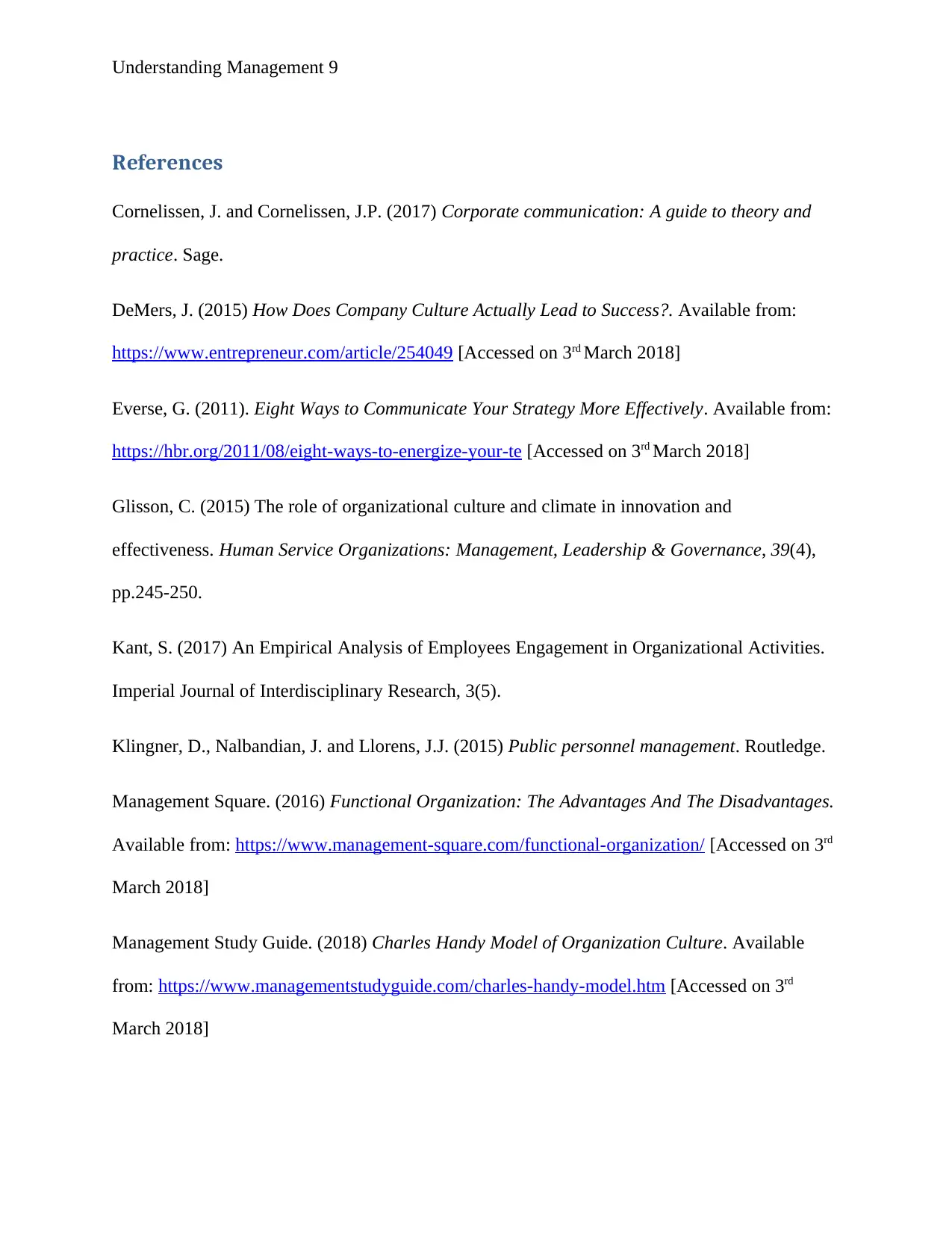
Understanding Management 9
References
Cornelissen, J. and Cornelissen, J.P. (2017) Corporate communication: A guide to theory and
practice. Sage.
DeMers, J. (2015) How Does Company Culture Actually Lead to Success?. Available from:
https://www.entrepreneur.com/article/254049 [Accessed on 3rd March 2018]
Everse, G. (2011). Eight Ways to Communicate Your Strategy More Effectively. Available from:
https://hbr.org/2011/08/eight-ways-to-energize-your-te [Accessed on 3rd March 2018]
Glisson, C. (2015) The role of organizational culture and climate in innovation and
effectiveness. Human Service Organizations: Management, Leadership & Governance, 39(4),
pp.245-250.
Kant, S. (2017) An Empirical Analysis of Employees Engagement in Organizational Activities.
Imperial Journal of Interdisciplinary Research, 3(5).
Klingner, D., Nalbandian, J. and Llorens, J.J. (2015) Public personnel management. Routledge.
Management Square. (2016) Functional Organization: The Advantages And The Disadvantages.
Available from: https://www.management-square.com/functional-organization/ [Accessed on 3rd
March 2018]
Management Study Guide. (2018) Charles Handy Model of Organization Culture. Available
from: https://www.managementstudyguide.com/charles-handy-model.htm [Accessed on 3rd
March 2018]
References
Cornelissen, J. and Cornelissen, J.P. (2017) Corporate communication: A guide to theory and
practice. Sage.
DeMers, J. (2015) How Does Company Culture Actually Lead to Success?. Available from:
https://www.entrepreneur.com/article/254049 [Accessed on 3rd March 2018]
Everse, G. (2011). Eight Ways to Communicate Your Strategy More Effectively. Available from:
https://hbr.org/2011/08/eight-ways-to-energize-your-te [Accessed on 3rd March 2018]
Glisson, C. (2015) The role of organizational culture and climate in innovation and
effectiveness. Human Service Organizations: Management, Leadership & Governance, 39(4),
pp.245-250.
Kant, S. (2017) An Empirical Analysis of Employees Engagement in Organizational Activities.
Imperial Journal of Interdisciplinary Research, 3(5).
Klingner, D., Nalbandian, J. and Llorens, J.J. (2015) Public personnel management. Routledge.
Management Square. (2016) Functional Organization: The Advantages And The Disadvantages.
Available from: https://www.management-square.com/functional-organization/ [Accessed on 3rd
March 2018]
Management Study Guide. (2018) Charles Handy Model of Organization Culture. Available
from: https://www.managementstudyguide.com/charles-handy-model.htm [Accessed on 3rd
March 2018]
Paraphrase This Document
Need a fresh take? Get an instant paraphrase of this document with our AI Paraphraser
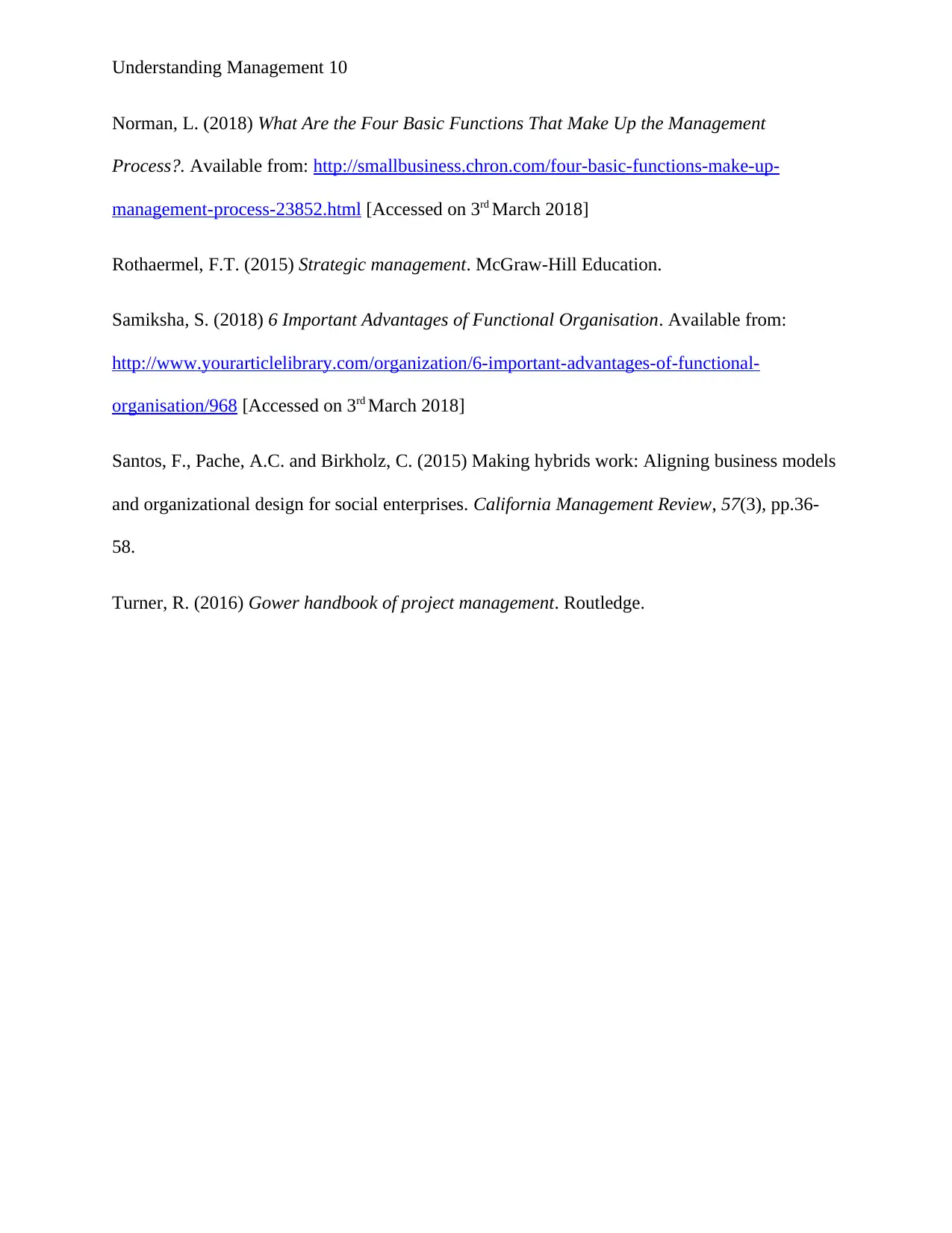
Understanding Management 10
Norman, L. (2018) What Are the Four Basic Functions That Make Up the Management
Process?. Available from: http://smallbusiness.chron.com/four-basic-functions-make-up-
management-process-23852.html [Accessed on 3rd March 2018]
Rothaermel, F.T. (2015) Strategic management. McGraw-Hill Education.
Samiksha, S. (2018) 6 Important Advantages of Functional Organisation. Available from:
http://www.yourarticlelibrary.com/organization/6-important-advantages-of-functional-
organisation/968 [Accessed on 3rd March 2018]
Santos, F., Pache, A.C. and Birkholz, C. (2015) Making hybrids work: Aligning business models
and organizational design for social enterprises. California Management Review, 57(3), pp.36-
58.
Turner, R. (2016) Gower handbook of project management. Routledge.
Norman, L. (2018) What Are the Four Basic Functions That Make Up the Management
Process?. Available from: http://smallbusiness.chron.com/four-basic-functions-make-up-
management-process-23852.html [Accessed on 3rd March 2018]
Rothaermel, F.T. (2015) Strategic management. McGraw-Hill Education.
Samiksha, S. (2018) 6 Important Advantages of Functional Organisation. Available from:
http://www.yourarticlelibrary.com/organization/6-important-advantages-of-functional-
organisation/968 [Accessed on 3rd March 2018]
Santos, F., Pache, A.C. and Birkholz, C. (2015) Making hybrids work: Aligning business models
and organizational design for social enterprises. California Management Review, 57(3), pp.36-
58.
Turner, R. (2016) Gower handbook of project management. Routledge.
1 out of 11
Related Documents
Your All-in-One AI-Powered Toolkit for Academic Success.
+13062052269
info@desklib.com
Available 24*7 on WhatsApp / Email
![[object Object]](/_next/static/media/star-bottom.7253800d.svg)
Unlock your academic potential
Copyright © 2020–2025 A2Z Services. All Rights Reserved. Developed and managed by ZUCOL.





